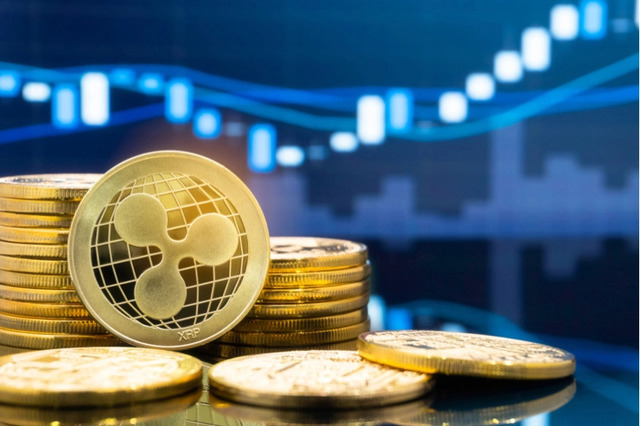Ripple CEO Predicts Crypto Market Explosion to $5 Trillion by 2024

I am a law graduate from NLU Lucknow. I have a flair for creative writing and hence in my free time work as a freelance content writer.

I am a law graduate from NLU Lucknow. I have a flair for creative writing and hence in my free time work as a freelance content writer.
Ripple harnesses the power of cryptocurrency and blockchain to pay for everyone, anywhere, anyway. Financial institutions can join the growing Ripple global network (RippleNet) to instantly, reliably, and cost-effectively process customer payments from anywhere in the world. Banks and payment processors can use XRP digital assets to cut costs and expand their market presence.
Ripple, a leading provider of enterprise blockchain and encryption solutions, has announced Ripple Liquidity Hub, a new solution for enterprise customers that will be available in 2022. Customers can access crypto assets on a variety of global platforms, including market makers. , a decentralized platform via exchanges, OTC tables, and future Ripple Liquidity Hub. Customers can easily buy, sell and store crypto assets thanks to turnkey product integration and smart order routing, allowing them to receive digital assets at the best price.
With plans to scale to more tokenized assets, the GA launch supports BTC, ETH, LTC, ETC, BCH, and XRP (availability varies by geographic location). Ripple plans to add new features like bidding support and monetization capabilities in the future.

Ripple has used Liquidity Hub for internal liquidity management for nearly two years as part of its On-Demand Liquidity (ODL) product, generating multi-million dollar transactions. Ripple will now serve hundreds of customers around the world, not just financial institutions, banks, fintech, or businesses that need help preparing for the imminent cryptocurrency world.
“We understand firsthand the need for simple and effective liquidity management, so we’ve been asked by clients looking for a solution that could be a one-stop shop for buying, selling, and storing crypto assets,” said Ashish Birla. RippleNet CEO.
Ripple’s cryptographic DNA and long history of partnerships with financial institutions provide a unique opportunity to help clients address this challenge as they prepare for a tokenized future.
Unlike other solutions on the market today, Liquidity Hub is tailored to the needs of enterprise customers.
Easy Onboarding: Provides an optimized API to access digital assets from diverse liquidity pools, enabling businesses to quickly integrate with liquidity hubs and provide trading services to clients, creating new revenue streams.
Optimized Pricing: Businesses can offer optimized aggregate prices for a wide range of digital assets, enabling them to offer their clients the best possible prices from a variety of liquidity sources.
Access to Capital: Businesses do not need to pre-fund their Liquidity Hub account and can access working capital through Ripple to finance their business operations.
Coinme is the largest network of licensed cryptocurrency exchanges in the United States, with thousands of locations across the country, and is Ripple’s first alpha product partner. Initially, Coinme plans to use its underlying technology platform, Liquidity Hub, and add additional features available.
“Coinme provides an easy and convenient way to exchange cash for cryptocurrencies. To provide our clients with optimal prices for a wide range of assets, we need 24/7 access to the liquidity to manage this vast network. “We are excited to work with Ripple to bring these benefits to our customers and businesses,” said Coinme CEO Neil Bergqvist.
Ripple was the first corporate company to use cryptocurrency to solve a multi-billion dollar cross-border payment problem. Since then, Ripple has evolved from a cross-border payment network to a platform that provides tokenized services, providing businesses with crypto opportunities and preparing for a future where cryptocurrencies are in the spotlight. Liquidity is critical to and supports any cryptocurrency experience.
Going forward, all clients will sign up for RippleNet with the same basic service and wallet that supports both crypto and fiat currencies. Customers can adopt this technology to stay on the cutting edge with the latest blockchain-based solutions. The platform is designed to seamlessly upgrade and add new services as customers wish. Customers can store anything tokenized in a Rippleenable-enabled wallet.
RippleNet closed its best quarter so far, announcing more than 20 new ODL markets, including new deployments in Japan and the Middle East and a 25x increase in the international flow of the network.
Ripple announced the creation of a liquidity hub as the company continues to seek legal action with the US Securities and Exchange Commission (SEC). The U.S. Securities and Exchange Commission (SEC) accused Ripple Labs CEO Brad Garlinghouse and co-founder Chris Larsen of raising more than $1.3 billion through XRP. sued with The Commission is considering an offer of unregistered securities.
The total digital currency industry amounts to over $600 billion, helping in the making of several new millionaires. One of the newest billionaires to benefit is Ripple’s former CEO, Chris Larsen. With a fortune amounting to a whopping $20 billion, Larsen’s revenue comes from XRP, which serves as the token of Ripple.
Ripple which he co-founded in 2012 with Jed McCaleb is a cryptocurrency based system that allows international payments. So how did this company that uses blockchain technology make Larsen a billionaire? Here’s the story of how Larsen made millions through Ripple and what the future holds for cryptocurrency.
Chris Larsen co-founded E-Loan in 1996, which worked as an online lender is the first company to provide free FICO credit scores. Within 4 years, Larsen grew the company and made it worth $1 billion. He then went on to sell it to Banco Popular in 2005. The next year he co-founded Prosper which he left in 2012, to co-found Ripple Labs Inc., which later developed Ripple. He stepped down in 2016, taking up the post of Executive Chairman. His stake in Ripple is estimated to be worth $37.3 billion, making him the 15th richest American.

Chris Larsen was born to a freelance illustrator mother and aircraft mechanic father in San Francisco. He obtained a BS in International Business from the San Francisco State University in 1984. Shortly after graduating, he started working for Chevron and then went on to do his M.B.A. from Stanford.
He and his colleague Janina Pawlowski, quit their jobs to found a mortgage company in 1992. By 1996, they raised $450,000 from friends and family and set up an office in Dublin. They made their E-Loan website public in 1997, and instantly tasted success.
By 1998, E-Loan was making $6.8 million annually and the company went public a year later. E-Loan was worth $1 billion by 2000, and in 2005 Larsen stepped down as CEO selling E-Loan to Banco Popular.
Larsen and John Witchel co-founded Prosper, which worked as an online auction marketplace like a Dutch auction system. He resigned as CEO in 2012 but stayed on as a Chairman. He then co-founded OpenCoin, which later became Ripple Labs, Inc. in 2013. Ripple Labs developed Ripple and by 2014, XPR was becoming a roaring success.
San-Francisco based Ripple facilitates secure international transactions and has grown 30,000% between 2017 and 2018. Hence, it has now passed Ethereum and has become the second-largest cryptocurrency in the world. By 2017, XRP’s market share amounted to US$73 billion. The explosive growth of Ripple is due to the launch of futures trading on Cboe and rising investor interest in digital currency.
XRP started out 2017 with a price of $0.006 and ended it by growing over 38000% to become valued at $2.30. In Ripple, the currency is a part of the payment system, unlike other systems wherein the currency is King. Hence, as the payment system is as important as the currency, it makes the entire process a lot safer and very flexible.
Larsen’s company holds over 61 billion of the total 100 billion XRP in circulation, making him one of the richest people in the world. His 17% stake in Ripple led to him being a part of Forbes’s list of richest people. The company is worth more than $410 million and has over 100 esteemed customers including the likes of Mitsubishi Financial and Bank of America.
The current CEO, Brad Garlinghouse, holds 6.3% stake in Ripple, making him worth nearly $10 billion. Jed McCaleb also served as a co-founder of Ripple but left in 2013 with 5.3 billion XRP.

Being a cinephile with a love for all things outdoorsy, Athulya never misses a chance to chase inspiring stories or poke fun at things, even when the subject is herself. Currently pursuing a degree in mechanical engineering, she is someone innately interested in technical and scientific research. Music reviews and op-eds define her as they allow her to explore different perspectives. Though sometimes she thinks she makes more sense playing the guitar than she does while writing.
Bitcoin successfully being steady at a higher value for a few months has faced a price drop in its value. Bitcoin is the largest cryptocurrency, and on Wednesday it experienced a sudden plunge in its value, shedding $400 within 30 minutes.
According to the CoinDesk data, the Bitcoin’s price drop has wiped billions of dollars from its market capitalization within minutes. It has also affected the values of other cryptocurrencies including Ripple (XRP), Ethereum, EOS, Stellar and Litecoin, dragging the value of each of them down, losing billions of dollars.
Bitcoin had attained a stability in its value, as recorded at the beginning of the month, the fall it has experienced has hit its 17-months volatility. The volatility comes when the value of the cryptocurrency gets into a state of stability, to end its stable trading. Also, the cryptocurrency trading by the whales (the people holding a huge share of cryptocurrency), also affects the price change of the cryptocurrency.
Bitcoin was having this stable state since September 17. The value of Bitcoin was above $6600, in the past week and has decreased sharply to $6,125. However, after some time of the price drop, Bitcoin recovered its value to an extent and reached briefly to $6,200.
The International Monetary Fund (IMF) had already published a warning that the rapidly growing value of the cryptocurrency assets can create “new vulnerabilities in the international financial system”. The warning came to be true when Bitcoin’s value dropped to 4.65 per cent, over the 24 hour period. Bitcoin, with its price drop, is hardly maintaining any gains this month. In just thirty minutes the cryptocurrency market capitalization fell from $214 billion to $205 billion.

Yashica is a Software Engineer turned Content Writer, who loves to write on social causes and expertise in writing technical stuff. She loves to watch movies and explore new places. She believes that you need to live once before you die. So experimenting with her life and career choices, she is trying to live her life to the fullest.